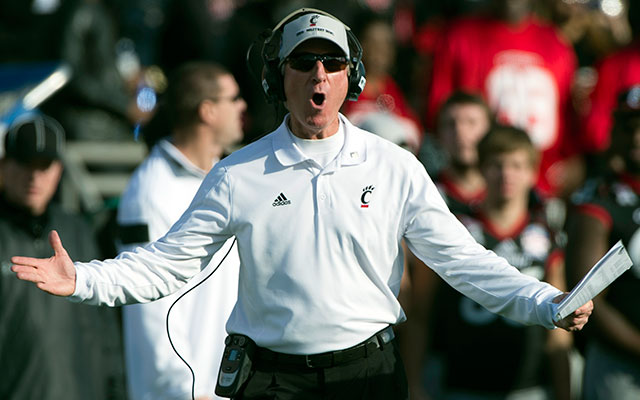Solomon: Can Cincy, Va. Tech fine players?
Inside College Sports is a weekly notebook looking at issues occurring off the field in college sports — big business, court cases, NCAA governance, health and safety, etc. Have a tip, idea or question about a certain topic? Email me at jon.solomon@cbsinteractive.com.
Cincinnati coach Tommy Tuberville and Virginia Tech defensive coordinator Bud Foster gave voice to a theory some people have believed for a while: Cost of attendance (COA) is not so much the new value of a scholarship as it is giving new money to players in exchange for athletic participation. Tuberville and Foster said this week they have considered withholding cost of attendance stipends from players for disciplinary reasons, causing some athletic directors across the country to cringe.
While Cincinnati is standing by this idea, Virginia Tech athletic director Whit Babcock quickly walked back Foster’s comments and said a proposed fine system won’t happen. Taking any money “out of cost of attendance would not be permissible and I shut it all down,” Babcock told The Roanoke Times on Wednesday. The Richmond Times-Dispatch on Thursday showed a television monitor outside the Virginia Tech players’ lounge that listed what appeared to be a fine structure and named players who had been assessed fines. Presumably, coach Frank Beamer must have had a say in these fines, which included $10 for missing a team breakfast or tutoring session, $45 for missing a class, $100 for drawing a personal foul penalty, and $100 and the loss of four tickets for improper equipment. The maximum fine could be $1,600 for a seventh offense. The screen showed five players had been fined a total of $330.
“If you’re not paying them, why are you fining them?” asked Michael Hausfeld, the lead attorney for Ed O’Bannon in a case that could allow athletes to be paid for use of their name, image and likeness. “This goes to the whole concept that the players are theirs as servants to the master. You want to punish them? Give them some rights. There has to be some sort of balance in the relationship.”
Generally speaking, reducing money from an athlete’s cost of attendance stipend or any other portion of the scholarship is not acceptable under NCAA rules. But schools have been allowed to reduce financial aid if he or she signs an agreement with certain non-athletic conditions in advance of the award period. A personal foul penalty would appear to represent an athletic condition. The NCAA did not respond with a comment for this article.
“The NCAA is pretty non-specific on what non-athletic conditions can be in an aid agreement,” said Ryan Squire, Illinois associate athletic director for compliance. “They don’t give us much guidance. Most schools put something in their agreement that aid can be reduced or cancelled for reasons such as violation of team rules or arrests.”
Fining players from their scholarship money “shows it’s an employee/employer relationship,” said National Collegiate Players Association executive director Ramogi Huma, who was unsuccessful trying to get the National Labor Relations Board to recognize Northwestern football players as employees who can unionize. “Whether they can do this under NCAA rules or not, it shows the mindset of how these coaches are considering treating their players like property.”
Tuberville’s comments, first reported by ESPN and reiterated in a statement to CBS Sports, stressed that a player’s effort off the field — not on the field — would factor into withholding COA. Cincinnati AD Mike Bohn told CBS Sports he’s frustrated by the perception that his athletic department could “fine” players. “We have simply helped our student-athletes know of our commitment to their success and our investment in them and what is at risk in the event they violate existing policies, procedures and team rules,” Bohn said.
Cincinnati has the highest COA figure in FBS, according to a CBS Sports survey. Bearcats senior associate AD Maggie McKinley said the school’s language in players’ financial aid agreements clearly spells out if they violate university, athletic department or team policies that their scholarship could be reduced or cancelled. Team rules can vary and be vague. Could a Cincinnati player’s COA be reduced if he is struggling academically but still eligible? McKinley said not unless that was clearly spelled out in the financial aid agreement. She added that being ineligible and in danger of ineligibility are “two very different things.”
Could COA be reduced if a player misses team meetings? “I think to insinuate that’s what we’re after would be an exaggeration,” Bohn said. “No, coaches at the University of Cincinnati don’t have autonomy to address those without engaging the entire campus.” As an example of how COA could be reduced, Bohn cited violating the law, such as assault charges. Bohn said Cincinnati is no different than other schools.
“This has nothing to do with football performance,” Tuberville said in a statement. “We have high standards our players will uphold and they will be held accountable. We will never duck from our commitment to support our student-athletes, but they know we expect them to be great citizens.”
The fascinating part of this conversation is seeing some coaches openly acknowledge their desire for money to incentivize certain conduct for players and the reaction to this interest. This isn’t what college sports leaders had in mind. It’s another issue they’re having to navigate in the new world of COA.
“I think that would be the wrong thing to do because cost of attendance isn’t being given to hang over a student-athlete’s head,” Arizona AD Greg Byrne said. “It’s given for them to help with their day-to-day living and expenses going to college. If you choose as a program not to (provide COA) because that’s where you are financially, that’s the reality. But you shouldn’t choose not to do it because of discipline. Take away playing time. Make them do community service. Run stairs. There are lots of things you can do.”
“I just wouldn’t want to take a kid’s money,” said another Power Five athletic director, who asked to remain anonymous. “The optics of it are just awful. Let me see: White man making $4 million a year tells a kid that he’s going to take some of his scholarship money?” This athletic director said the better approach is documenting all of the missteps by an athlete and using those to dismiss the player if necessary, not reduce financial aid. “We document like crazy and we’ve never lost (an appeal to the university),” the person said.
This discussion comes a week after the NLRB dismissed Northwestern football players’ petition to attempt to form a union. The NLRB didn’t rule on the question of whether the players are university employees. The pending O’Bannon and Jeffrey Kessler cases in court could allow players to be paid above their scholarship, including cost of attendance.
Kessler, the attorney suing the NCAA and its major conferences for a free market for players, said he is not familiar with some schools’ proposals to reduce COA money. “I’ll refrain from commenting until I know what’s being done,” Kessler said.
 |
Arizona AD: School spends $89,000 per athlete
|
|
Arizona athletic director Greg Byrne estimated that his department will spend on average $89,000 per scholarship athlete this year. How is that being counted? Byrne said the figure includes scholarships, food, clothing, equipment and travel; portions also account for the training room and strength and conditioning. Administrative and coaches’ salaries are not part of the average. In recent months, some Division I athletic directors have taken this approach in an effort to show how much they’re spending on players amid litigation. Of course, some of these costs also benefit the school because they’re trying to compete at a high level. “It helps us compete,” Byrne said. “I don’t think that’s a bad thing.” Playing devil’s advocate, should the schools permit the players to have a say in what they’re spending money on for them? Maybe players would want some of that money in their pocket instead of elaborate food or facilities. “I don’t think the food is too elaborate, and I think the facility is important to them,” Byrne said. “Student-athletes have made very clear they want a good environment to train in and study in and develop in.” |
|
 |
AAC may leave Rhode Island |
|
The American Athletic Conference may leave Providence, R.I., now that its membership has changed. Commissioner Mike Aresco confirmed the AAC has explored moving its conference headquarters. Aresco said the league has “several” more years left on its current lease and declined further comment. The AAC no longer has a team in Rhode Island after Providence joined the new Big East. Should the AAC decide to, Dallas would make sense as it is home to SMU (an AAC member), the College Football Playoff and several other conference offices. Dallas would certainly provide more college football media exposure than Rhode Island. |
|
 |
Read ’em |
|
Each week. this space will highlight some excellent recent work by college sports media on difficult topics to report. * Keith Sergeant of NJ.com reported that Rutgers is investigating whether football coach Kyle Flood impermissibly sent an email from his personal account to a faculty member regarding the status of a player who is in danger of being academically ineligible. Flood said he regularly interacts with professors. Faculty members disputed that a coach emailing a professor is common. * Auburn’s faculty department ended the football team’s most popular major (public administration). Then the athletic department intervened, reports Ben Cohen of the Wall Street Journal. * ESPN.com’s Max Olson and Mark Schlabach reported that records show Boise State officials were alarmed about Sam Ukwuachu’s erratic behavior during his final months on campus before transferring to Baylor. |
|
 |
Quote of the week
|
|
“It’s unfortunate that this is the focus of the time that was spent because there was a lot of really quality dialogue that took place in that weekend.” — USC coach Steve Sarkisian to The Los Angeles Times on a report by The Seattle Times that he was reimbursed $1,023 by Washington in 2012 and 2013 for alcohol consumed at two California retreats for coaches and spouses. At one of the retreats, a party of 16 had a drink tab of $522.80 with 46 shots of tequila. |
|
Follow and read more from Jon Solomon on Facebook and Twitter.
 Tommy Tuberville plans to fine Cincinnati players via their cost of attendance stipends. (USATSI)
Tommy Tuberville plans to fine Cincinnati players via their cost of attendance stipends. (USATSI)
This entry passed through the Full-Text RSS service – if this is your content and you’re reading it on someone else’s site, please read the FAQ at fivefilters.org/content-only/faq.php#publishers.